Remplex 2025 Summit - Poster Session
Tuesday, November 4, 2025 | 5:00 - 7 p.m. PT

The General Poster Session is open to all topics relevant to the remediation of complex sites. Examples include studies on characterization of contaminated sites; contaminant fate and transport; contaminant interactions and co-contaminant effects; conceptual model development and testing; chemical, physical, hydrological and microbiological controls over contaminant mobility; strategies and remedy development; and others.
Session Organizers: Alex Kugler, Pacific Northwest National Laboratory (PNNL); Amanda Lawter (PNNL), and Nik Qafoku (PNNL).
Advanced Rugged Gamma Imaging System with Enhanced Dynamic Range and Real-Time 3D Dose Mapping Victoria Anderson-Matthew, Innovative Physics, Ltd. ► View poster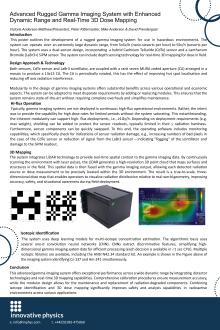
| This paper introduces a modular gamma camera system that combines dual-sensor technology with real-time three dimensional mapping to monitor radiation over nine orders of magnitude from 5 nano-sieverts per hour to 5 sieverts per hour. The system utilizes a hybrid Cadmium Telluride sensor for high-dose detection and Lanthanum Bromide for enhanced sensitivity. The camera includes depth sensing technology, thereby supporting three dimensional point cloud data creation to facilitate the projection of real-time radiation doses into physical spaces. This capability is coupled with machine learning-based isotopic identification, which provides an isotopic breakdown per hotspot basis. The camera system is modular, bestowing multiple benefits, including the ease of replacing internal components. This camera system is an all in one solution for waste management and sort and segregation allowing for deployment in a vast range of environments. Coauthors: Mike Anderson, Peter Kittermaster, and Shaun August (Innovative Physics, Ltd.)
|
Development of SiC-Based Neutron Detector Heads for High Radiation Environments Victoria Anderson-Matthew, Innovative Physics, Ltd. ► View poster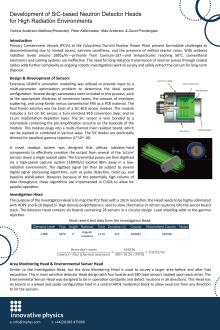 | The development of SiC-based neutron detector heads are designed for high radiation environments, such as the Primary Containment Vessels (PCVs) at the Fukushima Daichi Nuclear Power Plant. The detectors utilise enriched B10 as a conversion layer, with Geant4 simulations used to optimise the efficiency for neutron capture and reduce self-attenuation losses. The SiC diodes are electrically thinned for excellent gamma rejection. Each detector head contains up to two hundred eighty-eight sensors in various geometric configurations for maximum detection area. The modular construction allows for reconfiguration for deployment in a range of mixed neutron gamma fields. Preamplifier and amplifier circuits were designed for minimal noise and charge pile-up; the readout chain combines signals from multiple sensors for transmission via a single long coaxial cable. Testing demonstrated reliable detection of neutrons (<10nv) in gamma environments higher than sixty sieverts per hour, indicating SiC diodes as suitable detectors for neutron radiation in high gamma radiation backgrounds. Coauthors: Mike Anderson, David Prendergast, and Peter Kittermaster (Innovative Physics, Ltd.)
|
Soil Vapor Extraction and Biochar Adsorption for TCE Remediation under Varying Hydrogeochemical Conditions Eunice Babatunde, Ingram School of Engineering, Texas State University ► View poster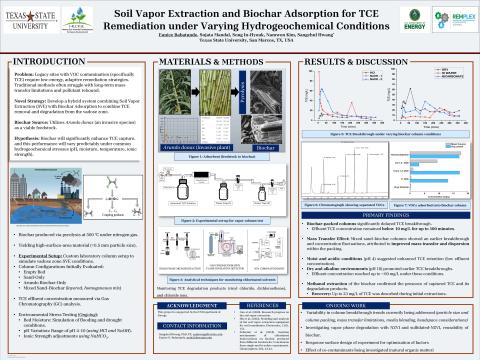 | To develop a low-energy, climate-adaptive remediation strategy suitable for legacy VOC-contaminated sites, this study explores the vapor-phase remediation of trichloroethylene (TCE) using a hybrid system that integrates soil vapor extraction (SVE) and adsorption with biochar derived from Arundo donax, an invasive plant species. Biochar was produced through controlled pyrolysis at 500 °C under nitrogen, resulting in fine, high-surface-area material (<0.5 mm) suitable for volatile organic compound capture. A custom laboratory column setup has been developed to assess system performance under simulated vadose zone conditions. Tests have evaluated four column configurations: (i) empty bed, (ii) sand-only, (iii) Arundo biochar-only, and (iv) a sand–biochar mixture. Gas chromatographic analysis revealed that the biochar-packed column significantly delays TCE breakthrough, maintaining the effluent concentrations below 10 mg/L for up to 100 minutes. Mixed sand–biochar columns showed an increased TCE breakthrough and concentration fluctuations, likely due to improved mass transfer and dispersion. Environmental stress testing is ongoing and includes simulation of flooding and drought conditions, pH variation (4–10), and ionic strength adjustment using NaOH, HCl, and NaHCO₃. Early results suggest enhanced TCE retention under moist and acidic conditions, while dry and alkaline environments promote earlier breakthroughs (up to ~60 mg/L). Methanol extraction has confirmed the presence of adsorbed TCE and degradation products, with up to 23 mg/L of TCE desorbed during initial extractions. These early findings demonstrate the promise of Arundo donax biochar for vapor-phase TCE capture under dynamic environmental conditions. Current work is focused on optimizing column design, improving media permeability using lightweight clay aggregate blending, and evaluating surface modifications to enhance in-situ remediation processes. Coauthors: Sujata Mandal, Song In-Hyouk, Namwon Kim, Sangchul Hwang (Texas State University) |
From Concept to Application: Installation of an Injectable Permeable Reactive Barrier at the Chalk River Laboratory Site Lee Bellan, Canadian Nuclear Laboratories ► View poster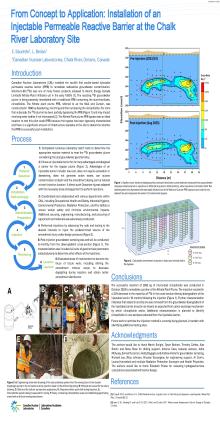 | In October 2024, Canadian Nuclear Laboratories installed an injectable permeable reactive barrier (IPRB) to intercept and remediate a portion of a Strontium-90 plume that is currently bypassing an existing permeable reactive barrier (PRB). IPRBs provide many benefits over traditional PRBs because the amendments can be delivered to the affected aquifer without excavation, dewatering and effluent management, offering a low-cost option to supplement existing treatment systems and prolong their lifespan. The co-ordination of the injection required the collaboration of Occupational Heath and Safety, Industrial Hygiene, Environmental Protection, Radiation Protection, and Fire Safety to ensure worker safety and minimize environmental effects. Special consideration was given to the protection of species at risk in accordance with the Species at Risk Act (S.C. 2002, c. 29), which involved planning the work to occur outside of the known turtle migration season. Additionally, the sourcing, engineering, manufacturing, and organization of equipment and materials required to perform the injection was extensive. Services such as drilling, sources of water and power, and the delivery and lay down of amendment materials required careful coordination. The amendment delivery system design, from mixing the amendment slurry and transferring it to the injection tooling, was engineered to ensure amendment delivery into the plume under design pressures. Injection pressures and impacts to the local water table, were continuously monitored during the entire injection process. Finally, adjustments to the planned design and delivery methods were made while performing the injection and these will be discussed with lessons learned. This poster presentation provides a detailed explanation of the administrative and practical considerations required for the successful installation of the IPRB. Coauthor: Emily Saurette (Canadian Nuclear Laboratories)
|
Addressing Low Levels of PFAS in Soil: A Local Case Study Amoret Bunn, Pacific Northwest National Laboratory ► View poster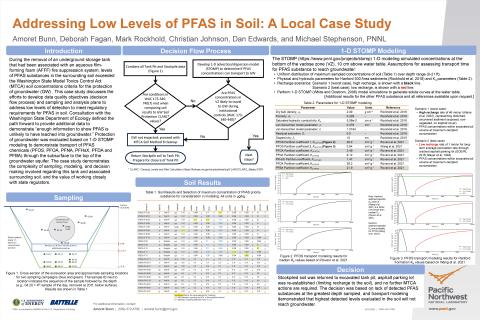 | During the removal of an underground storage tank that had been associated with aqueous film-forming foam (AFFF) fire suppression system for a research building, levels of PFAS substances in the soil were found to exceed the Washington State Model Toxics Control Act (MTCA) criteria for soil concentrations for groundwater protection. This case study discusses the efforts to develop data quality objectives and sampling and analysis plans to address low levels of detection to meet regulatory requirements for PFAS in soil. Consultation with the Washington State Department of Ecology defined the path forward to provide additional data to demonstrate “enough information to show PFAS is unlikely to have leached into groundwater.” This direction from the state regulators is an indication of the evolving process as new criteria for PFAS in soil are published and the involved parties identify the appropriate steps to meet regulations. To address protection of groundwater, a decision flow process defined the lines of evidence to meet objectives for a second round of soil sampling below the removed tank, and the approach for modeling the detected PFAS substances. Protection of groundwater was evaluated based on 1-D STOMP (Subsurface Transport Over Multiple Phases) modeling to demonstrate transport of PFAS chemicals (PFOS, PFOA, PFNA, PFHsX, PFDA and PFBA) through the subsurface to the top of the groundwater aquifer. The case study demonstrates the complexity of sampling, modeling, and decision making involved regarding this tank and associated surrounding soil, and the value of working closely with state regulators. Coauthors: Debbie Fagan, Mark Rockhold, Christian Johnson, Dan Edwards, and Michael Stephenson (PNNL) |
Webased Visualization of Surface Complexation-Ion Exchange (L-SCIE) Database Fanny Coutelot, Clemson University ► View poster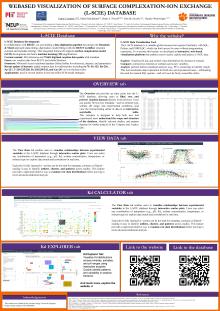 | The Surface Complexation/Ion Exchange (L-SCIE) Database[1], developed by LLNL, provides a consistent set of thermodynamic constants describing radionuclide interactions at mineral-water interfaces. This resource enhances the accuracy of input parameters for assessing nuclear waste repository performance and offers comprehensive data for advancing our understanding of the fundamental chemistry governing radionuclide reactions in these environments. The database comprises digitized sorption data from literature sources, particularly those found in RES3T. A recent update from Clemson has incorporated information on the sorption of key radionuclides (79Se, 152Eu, 226Ra, 237Np, 234,235,238U, 238,239,242Pu, and 241Am) onto iron (hydro)oxide minerals produced during steel corrosion. Several publications have used this database to test model strategies. The tool provides three primary functionalities: Explore, Compare, and Analyze. The Explore functionality enables users to select an element (sorbate) or mineral within L-SCIE and visualize the distributions of pH, Kd, and sorbed values within the selected variables, along with the associated summary statistics. The Compare functionality allows users to select two minerals or sorbates and visually compare them with respect to various variables. The Analyze functionality permits users to conduct statistical analyses to identify patterns within the selected datasets; Principal Component Analysis (PCA) and clustering are two of the available options. Seasoned L-SCIE researchers can also benefit from this instrument, as it can substantially accelerate the typically laborious and lengthy tasks of crafting SQL queries and manually creating visualizations for extracted data. Any interested researcher can use the L-SCIE data visualization tool for free to quickly and conveniently conduct a preliminary investigation on L-SCIE with a few mouse clicks. The web server with the database and its additional summary tables used for our analysis will soon be available online. Coauthors: Maria Macfarlane (Massachusetts Institute of Technology [MIT]), Brian A. Powell (Clemson University), Mavrik Zavarin (Lawrence Livermore National Laboratory), Haruko Wainwright (MIT) |
AIML for PFAS Contamination Source Attribution Debbie Fagan, Pacific Northwest National Laboratory ► View poster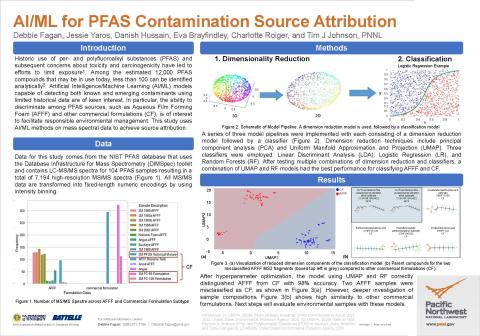 | PFAS (per- and polyfluoroalkyl substances) contamination is an acute challenge for environmental stewards. Whether it be monitoring releases to the environment from known PFAS sources, identifying PFAS in an environment, or verifying PFAS destruction products, it is crucial to be able to quickly understand the PFAS signatures that result from various sources for several reasons, including: 1) discriminating among PFAS sources to ensure responsible environmental management decision making, 2) evaluating the baseline condition that will be used to determine ecological and human health effects attributed to on-site sources, and 3) efficient verification of environmental removal or remediation of PFAS. For those methods using mass spectrometry, there are a wide variety of artificial intelligence and machine learning (AIML) techniques for identifying and characterizing compounds from collected mass spectral data. These tools are often tailored to specific regions of “chemical space” or atomic mass ranges, or alternatively, tailored to specific mass spectral data types (e.g., lower resolution gas chromatography mass spectrometry or high-resolution liquid chromatography mass spectrometry). As there are over 10,000 different PFAS formulations, source attribution is prime for ML techniques applied to spectra from various analytical methods. At PNNL, there are a variety of previous and ongoing projects that focus on AIML for small molecule identification, activity prediction, and quantification from mass spectral data of different types (e.g., GS-MS and LC-MS/MS data). While the majority of these efforts have focused on small molecules such as opioids, the fundamental methods may transfer to the PFAS characterization challenge. We aim to leverage the ongoing AIML research and expand it to assist in identifying PFAS substances, even where conventional LC-MS/MS may not be able to discern the substance due to interferences, high detection or quantitation limits, or where analytical methods are yet to be approved. In the present effort, we have developed a computational pipeline to ingest PFAS LC-MS/MS data from the National Institute of Standards and Technology (NIST) PFAS database, perform data pre-processing, and apply ML algorithms to differentiate amongst PFAS sources. By leveraging an experiment tracking dashboard, built with MLflow, we have explored a suite of different workflows, models, model parameters, and results. This approach enables rapid model testing while maintaining robust documentation. We will show modeling approaches, workflow optimization, and preliminary results of source attribution. Coauthors: Jessie Yaros, Danish Hussain, Eva Brayfindley, and Tim J. Johnson (PNNL) |
Treating More with Less: Hybrid Ion Exchange Resins for the Remediation of Comingled Groundwater Contaminants Jacqueline Hager, Pacific Northwest National Laboratory ► View poster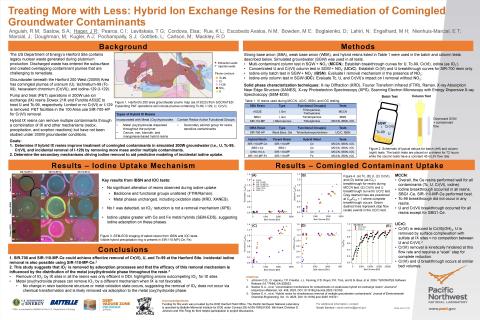 | Ion exchange (IX) resins are commonly used for the remediation of contaminated groundwater at pump and treat (P&T) facilities. Resins deployed in these facilities consist of copolymer backbones with functionalized groups that leverage IX processes to remove aqueous cation or anion contaminants. These conventional resins are typically designed to be highly selective for only one contaminant ion. This is true at the Hanford Site’s 200 West (200W) P&T facility, where anion IX resins are deployed in a series of columns for the remediation of groundwater plumes containing uranium (U, as uranyl carbonate) and technetium-99 (Tc-99, as pertechnetate), using Dowex 21K and Purolite A532E IX resins, respectively. Expansion of 200W P&T operations will include extraction wells that access groundwater plumes with comingled Tc-99, U, hexavalent chromium (Cr(VI), as chromate), and/or iodine-129 (I, as iodate). Incorporating additional single-contaminant-selective resins for Cr(VI) and incidental I removal into the current P&T facility would be expensive and time consuming. However, emerging “hybrid” resins are designed to remove multiple contaminants via IX and an additional mechanism (e.g., redox, precipitation, sorption) and are potential alternatives for treating comingled contaminants without expanding P&T operations. Lab-scale batch and column tests were performed to evaluate the performance of a suite of hybrid resins in ultrapure water and simulated Hanford groundwater. Performance was based on contaminant removal of Tc-99, U, I, and Cr(VI) in the presence of competing groundwater ions and comingled contaminants. Solid phase characterization using spectroscopy, electron microscopy, and X-ray diffraction was conducted on unreacted and reacted resins to determine the removal mechanisms for each contaminant. A combination of two resins, SIR-700-HP (redox active hybrid) for U and Cr(VI) removal and SIR-110-MP-Ce (cerium hybrid) for Tc-99 and incidental I removal, are proposed as a potential approach for meeting cleanup objectives during expansion of 200W P&T operations. Coauthors: Sarah Saslow, Carolyn Pearce, Tatiana Levitskaia, Rachel Anguish, Elsa Cordova, Kelly Rue, Nancy Escobedo, Mark Bowden, Daria Boglaienko, Nabajit Lahiri, Mark Engelhard, Emily Nienhuis-Marcial, Jose Marcial, Mariah Doughman, Alex Kugler, and Suraj Pochampally (PNNL); Larry Gottlieb (ResinTech, Inc.); Mark Carlson (Oregon State University) |
Technical and Regulatory Approaches for Cleanup of Contaminated Groundwater at Test Area North at the INL Pete Johansen, Idaho Department of Environmental Quality ► View poster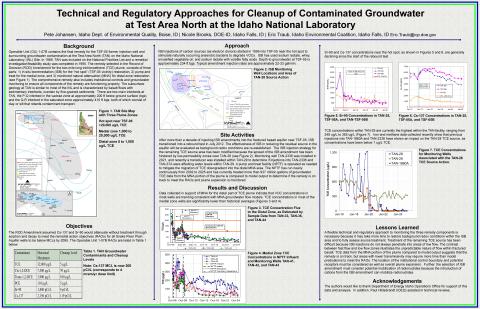 | Background: Operable Unit (OU) 1-07B contains the final remedy for the TSF-05 former injection well and surrounding groundwater contamination at the Test Area North (TAN) on the Idaho National Laboratory (INL) Site. The remedy selected in the Record of Decision (ROD) Amendment for the two-mile long trichloroethene (TCE) plume, consists of three parts: 1) in-situ bioremediation (ISB) for the “hot spot” (TSF-05 vicinity) restoration, 2) pump and treat for the medial zone, and 3) monitored natural attenuation (MNA) for distal zone restoration. The comprehensive remedy also includes institutional controls and groundwater monitoring to ensure all components of the remedy are functioning properly. The ROD Amendment assumed Cs-137 and Sr-90 would attenuate without treatment through sorption and decay to meet the remedial action objectives (RAOs) for all wells to be below MCLs by 2095. Approach: After more than a decade of injecting ISB amendments into the fractured basalt aquifer near TSF-05, ISB transitioned into a rebound test in July 2012. The effectiveness of ISB in reducing the residual source in the aquifer will be evaluated as background redox conditions are re-established. The ISB injection strategy for the remaining TCE source area has been modified because the spread of the ISB amendment has been hindered by low-permeability zones. A pump and treat facility (NPTF) is operated as needed to mitigate the migration of TCE downgradient into the distal MNA area. TCE data from the MNA portion of the plume is compared to model output to determine if the remedy is on track to meet the RAOs. Results: A flexible technical and regulatory approach to monitoring the three remedy components is necessary because it may take more time to restore background redox conditions within the ISB area and to fully assess source treatment. Treatment of the remaining TCE source has been difficult because ISB injections do not always penetrate into areas of low flow. The contrast between fast flow and low flow zones illustrates the unpredictable nature of flow within fractured bedrock. TCE data from the MNA portion of the plume compared to model output suggests that the remedy is on track, but areas with lower transmissivity may require more time than model predications to meet the RAOs. The location of the institutional control boundary and potential receptors must be considered as well as overall plume expansion. Further, the selection of ISB amendment must consider potential mobilization of radionuclides because the introduction of cations from the ISB amendment can mobilize radionuclides. Coauthors: Eric Traub (Idaho Environmental Coalition), Nicole Brooks (U.S. Department of Energy, Idaho Operations Office) |
Statistical Analysis of Hanford Data to Determine Representative Groundwater Formulations Christian Johnson, Pacific Northwest National Laboratory ► View poster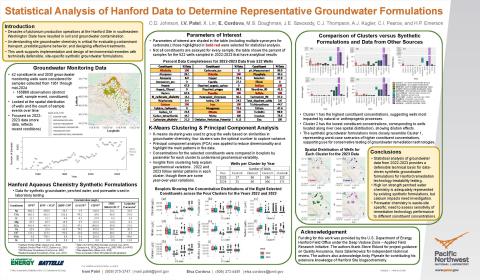 | Selection of a remediation technology for in situ remediation of contaminants is based on the key factors of effectiveness and implementability, among others, both of which typically depend on the site-specific context. After an initial screening of potential technologies, an assessment of treatment technology performance is often done through laboratory treatability testing under site-specific conditions, which would involve sediment and groundwater from the site. Synthetic groundwater that mimics the properties of site groundwater, instead of actual groundwater, is useful in laboratory testing, for multiple reasons. An advantage of synthetic groundwater for studies is that it provides controlled conditions to assess the impacts and interactions between treatment technology performance and key parameters (e.g., pH, alkalinity, contaminant, etc.). The use of synthetic groundwater also facilitates consistency and reproducibility of experiments. Additionally, synthetic groundwater has cost and practical benefits including ease of preparation, availability of adequate volumes, and straightforward disposal—compared to actual groundwater, which requires field collection, transportation, more complicated/costly disposal, and for which adequate volumes may not be available. With these advantages in mind, a holistic evaluation of spatial and temporal aqueous geochemistry data from the U.S. Department of Energy Hanford Site in southeastern Washington state was used to develop a technically defensible synthetic groundwater formulation for the site. Cluster analysis and principal component analysis were used to assess key chemical constituents and the spatial distribution of data for the clusters. The analysis resulted in potential representative synthetic groundwater formulations that could be used in current and future laboratory treatment tests for the Hanford Site. For example, nine technologies are being evaluated in treatability tests to determine suitability for application in the Hanford Site’s 200-DV-1 Operable Unit. The analysis of data and determination of a technically defensible, statistically sound representative groundwater formulation provides a solid basis for understanding treatability testing results, comparability of results from multiple studies, and interpreting implications for remediation applications across the site. The approach to assessing groundwater data and the outcomes in determining the representative formulation are described in this poster. Coauthors: Ivani Patel, Elsa Cordova, Mariah Doughman, Jim Szecsody, Christopher Thompson, Alex Kugler, Carolyn Pearce, and Hilary Emerson (PNNL) |
A Multi-Faceted Modeling Framework for Transforming Remediation Visions into Tangible Realities Prashanth Khambhammettu, Arcadis, Inc. ► View poster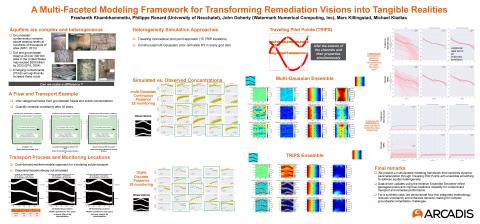 | Expenditures for soil and groundwater cleanup at over 300,000 sites in the United States may exceed $200 billion (not adjusted for inflation) by the year 2033 (USEPA 2004). These sites are typically underlain by heterogeneous formations where low-permeability zones act as secondary contaminant sources via back diffusion, prolonging remedial timeframes. While complex numerical models are often used at these sites in a deterministic form for supporting remedy design, their utility is frequently hampered by insufficient data and a disconnect between the underlying CSM and the numerical model. Moreover, deterministic approaches underestimate predictive uncertainty, often leading to increased lifecycle costs and/or remedy failure. In this presentation, we demonstrate a multi-faceted modeling framework to transform remediation visions into tangible realities. Using MODFLOW 6, we simulate a triple porosity system consisting of a mobile and two immobile domains with quick and slow mass exchange, respectively. This system better approximates the 3-compartment model that characterizes the aquifer into fast, slow, and static groundwater. We include “conceptual pilot points” to represent the geometries of the preferential flow pathways (e.g., sinuous braided channels). Furthermore, to address inherent predictive uncertainty, we use ensemble smoothers to generate a "multiverse" of likely models by conditioning groundwater parameter fields to aquifer state measurements. By combining these advanced transport conceptualizations with robust uncertainty quantification, this framework brackets predictive uncertainty, providing site managers, regulators, and stakeholders a spectrum of likely outcomes for better-informed decision-making. Coauthors: Michael Kladias, Scott Potter, and Marc Killingstad (Arcadis, Inc.) |
Using Multiple Lines of Evidence to Assess a Legacy Waste Management Area Lesley Knight, Canadian Nuclear Laboratories ► View poster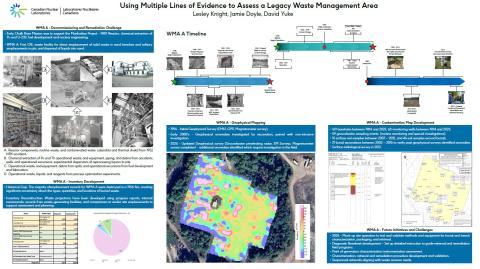 | Canadian Nuclear Laboratories (CNL) manages Canada’s nuclear legacy liabilities on behalf of Atomic Energy of Canada Limited (AECL) and the Government of Canada. CNL’s environmental clean-up mission is the largest and most complex decommissioning and environmental remediation program in the country. CNL is currently executing clean-up work at six different sites across Canada. The largest site is Chalk River Laboratories (CRL), which is home to numerous waste management areas and affected lands in varying stages of environmental remediation. Waste Management Area A (WMA A) was the first radiological waste disposal area at CRL. From 1946 to 1953, operating as CRL’s primary radioactive waste disposal site, with an estimated 17,000 m3 of material placed into unlined sand trenches, along with numerous discrete object burials and liquid dispersal pits. WMA A also served as an infiltration area for approximately 3.8 million litres (1 million gallons) of contaminated cooling water after the 1952 National Research Experimental (NRX) reactor accident. A large volume of emplacement records for most material buried at WMA A were destroyed in a 1956 fire. This has hindered the ability to accurately identify the types and quantities of waste present. To safely proceed with environmental assessment and remedial planning at WMA A, multiple lines of evidence are used to corroborate the existence and location of buried waste. Various characterization methods, including soil and groundwater sampling, geophysical surveying, and non-intrusive assessments of the burials are some of the lines of evidence being employed at WMA A. In addition to this, detailed review of facility operational records along with comparison to nearby facilities with similar operations are being used to assess the potential hazards associated with the waste to further plan for retrieval and remediation. This poster highlights how multiple lines of characterization connect to improve our planning for future activities. Coauthors: Jamie Doyle and David Yuke, Canadian Nuclear Laboratories |
Geochemical Considerations and Remediation of Cyanide at Complex Sites Using Batch and Flow Experiments Alex Kugler, Pacific Northwest National Laboratory ► View poster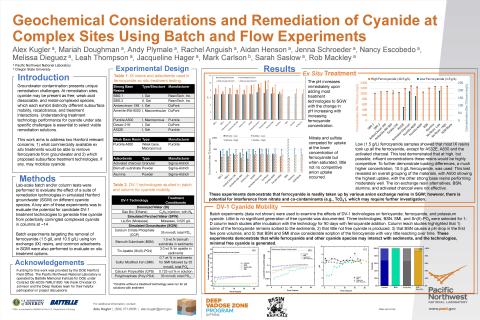 | Groundwater contamination by cyanide at active and legacy industrial and manufacturing sites presents unique remediation challenges due to the potential for acute toxicity, variable speciation, and interactions with co-occurring metals and organic pollutants in heterogenous subsurface environments. At complex sites, cyanide may be present as a free ion, weak-acid, and/or metal-complexed species with each exhibiting distinctly different mobility in the subsurface. Moreover, during active remediation, there may be changes in speciation and/or impacts on remediation efficacy for other contaminants. The Department of Energy’s Hanford Site (Richland, Washington), is a complex remediation site where multiple contaminants, including cyanide species, comingle. Understanding treatment technology performance for cyanide under site specific conditions is essential to down-select viable remediation solutions. Lab-scale batch and column tests were conducted to evaluate the effect of a suite of remediation technologies in simulated Hanford Site conditions. One interaction of concern between any in situ treatments and complexed cyanide is the potential for the release of free cyanide. A key aim of these experiments was to evaluate the potential for candidate treatment technologies to generate free cyanide from potentially comingled, complexed cyanide. Of the technologies evaluated none showed a high likelihood of transforming complexed cyanide into free cyanide. In addition, ex situ batch experiments targeting the removal of ferrocyanide from solution using ion exchange (IX) resins highlighted that at low concentrations many anion resins are capable of removal, including those currently used at the Hanford 200 West Area pump and treat facility. These IX resins, however, also removed nitrate, and other anions. However, at higher concentrations select commercially available IX resins outperformed with Purolite A500 removing the most total cyanide. These experiments highlight the importance of testing variables in site-specific conditions and suggest that targeted treatment of cyanide even comingled with other anions is possible at complex sites. Coauthors: Mariah Doughman, Andy Plymale, Rachel Anguish, Aidan Henson, Jenna Schroeder, Nancy Escobedo, Melissa Dieguez, Leah Thompson, and Jaqueline Hager (PNNL); Mark Carlson (Oregon State University); Sarah Saslow and Rob Mackley (PNNL) |
Geophysical Imaging Fluid Flow and Transport – Dual Gamma (GIFT-DG) Capabilities and Initial Experiments to Evaluate Subsurface Remediation Design and Performance Dory Linneman, Pacific Northwest National Laboratory ► View poster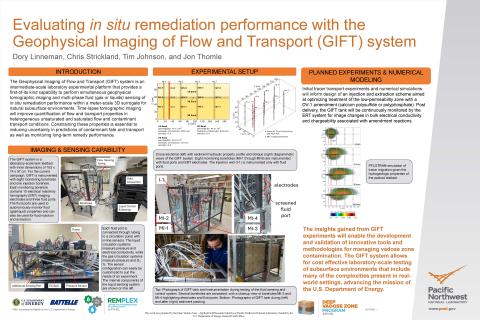 | Development and validation of new monitoring technologies can benefit from laboratory experiments that reproduce as many aspects as possible of real-world natural systems. Given that heterogeneities are nearly always present and can often influence system behavior, tests that incorporate heterogeneities and can approach near field-scales would be advantageous. The Geophysical Imaging of Flow and Transport (GIFT) system is an intermediate-scale laboratory experimental platform. The GIFT will provide a first-of-its kind capability to perform simultaneous tomographic imaging using geophysical measurements and multi-phase (gas or liquids) measurements. Time-lapse tomographic imaging will improve quantification of flow and transport properties in heterogeneous unsaturated and saturated flow and contaminant transport conditions. Constraining these properties is essential to effectively reducing uncertainty in predictions of field-scale contaminant fate and transport as well as monitoring long term remedy performance. Here we present the GIFT-DG design, that has been configured and built to perform meter-scale controlled fluid flow and contaminant experiments in the lab. Initial experiments will be performed under saturated conditions and used to mimic a groundwater remedy injection (e.g., liquid-based amendment to decrease contaminant mobility). Data sets will be utilized to validate novel geophysical data processing/inversion approaches and their applicability to environmental remedy monitoring by providing a well understood system (e.g. known spatial distribution of permeability and porosity) that can be compared to geophysical derived parameter estimates. Coauthors: Chris Strickland, Tim Johnson, and Jonathan Thomle (PNNL) |
Hand-Portable DartTM technology for Characterization and Monitoring of Hydrogeologic Properties of the Subsurface Darya Morozov, Vista Clara, Inc. ► View poster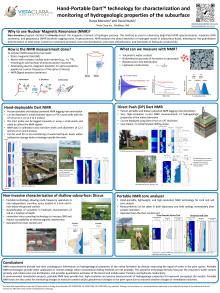 | Nuclear Magnetic Resonance (NMR) is a powerful, non-destructive, and non-radiative technique widely used across scientific disciplines, including chemistry, medicine (e.g., MRI), and earth sciences. In geosciences, NMR enables the direct detection of hydrogen nuclei in subsurface fluids, allowing for the quantitative determination of total water content (or saturated porosity), pore size distribution, pore type classification, and estimates of hydraulic conductivity. These measurements are particularly valuable for high resolution site characterization (HRSC) and monitoring in environmental remediation projects. Since 2009, Vista Clara Inc. has introduced a range of NMR technologies with broad applications across geoscience markets, including environmental remediation, groundwater resource assessment, and mining. These technologies include the Javelin borehole logging probes and the GMR surface NMR system for non-invasive subsurface investigations. This talk will focus on the hand-portable Dart family of products, which includes compact, high-resolution Dart NMR logging probes that can be deployed via direct-push methods or used to collect in-situ NMR data from small-diameter plastic access tubes. Also highlighted are the Helios Trek system, a portable tool for NMR analysis of freshly extracted soil and core samples both in the field and in laboratory settings, and the Discus sensor, a unilateral NMR device that enables non-invasive measurement of hydrogeologic properties in the very shallow subsurface—up to 6 inches deep. We will begin with an overview of the geophysical principles underlying NMR. We will then introduce each of the key Dart NMR products and highlight their potential applications in environmental remediation and monitoring projects. Finally, we will present a recent proof-of-concept project conducted in collaboration with Sellafield, where Dart logging technology has been proposed for in-situ monitoring of waste bed liquor levels within Sellafield storage compartments. Coauthors: Darya Morozov, Cristina Penner, Anh Nguyen, Dat Nguyen, and David Walsh (Vista Clara, Inc.) |
Source-Separated Sanitation to Improve Soil Remediation Potential of Human Manure-Based Soil Amendments Trisha Nickerson, University of Colorado Boulder ► View poster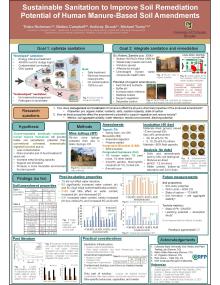 | Globally, humans generate around 340 billion kilograms of feces yearly and the valuable resources within– organic matter, microbes, and nutrients – are what degraded mine soils need to stabilize, hold water, and revegetate. However, many low-income regions do not have access to safe excreta management and high-income regions use resource-intensive wastewater treatment processes that contaminate solids, limiting their use. Here, we consider how integrating sustainable human sanitation programs with clean-up projects could improve long-term restoration outcomes and provide additional benefits to affected communities. In this study, we compare source-separated, aerobically composted humanure to biosolids from a conventional wastewater treatment plant for their potential to stabilize a degraded mining soil. Mine waste rock from Idaho Springs, CO, topsoil, and humanure-derived amendments, are combined to mimic mine closures and incubated to initiate soil aggregation and metal complexation. We compare metrics such as wet aggregate size fractions, porosity, water holding capacity, nutrient/metal contents, leaching propensity, and stability in acidic conditions to predict the potential for soil formation and revegetation. We test the hypothesis that source separation and composting is more likely to stabilize metals in larger aggregates and improve stability in acidic conditions due to their higher degree of aromaticity and oxygen functionalization, reduced initial contaminant loading, improved pH buffering capacity, and higher water retention capacity, as found in previous studies. Coauthors: Michael F. Toney and Anthony P. Straub (University of Colorado Boulder)
|
Characterization and Monitoring of Fugitive Emissions at the DuPont FUSRAP Site Satish Nune, Pacific Northwest National Laboratory ► View poster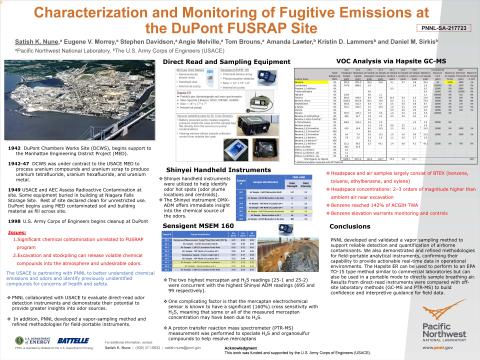 | The DuPont Formerly Utilized Sites Remedial Action Program (FUSRAP) site in Deepwater, NJ contains radioactive contamination as a result of uranium processing activities conducted in the 1940s. Challenges at the site go beyond addressing the radiological contamination and include highly toxic chemical waste present in the soil. Excavation of this radiologically contaminated material results in hazardous vapor emissions which require monitoring and proper level of personal protective equipment and engineering controls. The U.S. Army Corps of Engineers (USACE) Philadelphia District tasked the Pacific Northwest National Laboratory (PNNL) with characterizing and monitoring vapor emissions and odors from excavation of contaminated soils. The objectives of the study were to 1) monitor vapors in the field for real-time analysis 2), compare the capability of portable instruments to analysis via commercial laboratories, 3) determine the effectiveness and cross-sensitivities of direct read instrumentation, 4) find an offsite laboratory for accurate quantitation for supplemental emission analysis and 5) compare these results to occupational exposure limits (OELs). Commercial laboratories often fall short in detection sensitivities and/or library of compounds for air sampling analytical methods and report results with unknown tentatively identified compounds (TICs). Portable instruments used on-site revealed that major contributors of odors at the site included mercaptans and hydrogen sulfide (H₂S). This led to identification of unknown chemicals such as a heavier class of mercaptans which were not identified by ASTM D5504 method which is routinely used for the detection of sulfur compounds. The effectiveness of proton transfer reaction-mass spectrometry (PTR-MS), selected ion flow tube mass spectrometry (SIFT-MS), and portable gas chromatograph and mass spectrometer (GC-MS) in quantifying organo-sulfur compounds and VOCs will be reported. This paper will highlight the analytical methods used to confidently monitor and measure fugitive emissions and their risks for other FUSRAP and environmental remediation projects. Coauthors: Kristin D. Lammers, Daniel M. Sirkis, and Lindsay Keller (U.S. Army Corps of Engineers); Eugene V. Morrey and Tom M. Brouns (PNNL) |
Integrating Induced Polarization and Spectroscopy Into Microfluidics to Map Apatite Precipitation for Subsurface Remediation Klaudio Peshtani, Pacific Northwest National Laboratory ► View poster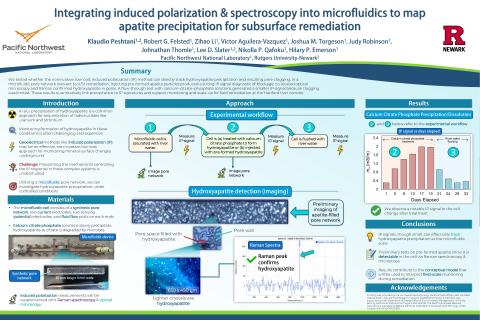 | In recent decades, geoelectrical techniques such as induced polarization (IP) have shown promise as effective, non-invasive, low-cost tools in monitoring in environmental systems. Previous investigations have demonstrated that IP is highly sensitive to mineral precipitation and resulting physical pore clogging. However, pinpointing the mechanisms behind the response in complex subsurface systems remains challenging. Milli- and microfluidics have been implemented to allow testing under highly controlled conditions to isolate these effects, although their use in IP is still relatively new. In situ precipitation of apatite is a common approach for sequestration of radionuclides (e.g., uranium and strontium) within the subsurface due to its ability to form strong complexes and low solubility phases. In this work, we utilized a microfluidic pore network to investigate apatite precipitation under controlled, flow-through conditions. Here, injection of pre-formed apatite particles produced a notable IP response, consistent with clogging of pores with apatite. Optical microscopy and Raman spectroscopy confirmed the presence of apatite in the pore network. These results establish a direct, quantitative link between apatite clogging pores with an IP signal. Furthermore, these findings incrementally improve our conceptual model which is necessary to lay the groundwork for targeted field-scale remediation experiments utilizing calcium-citrate-phosphate amendments along the river corridor at the U.S. Hanford Site. Coauthors: Robert G. Felsted, Zihao Li, Victor Aguilera-Vasquez, Joshua M. Torgeson, Judy Robinson, and Jonathan Thomle (PNNL); Lee D. Slater (Rutgers University - Newark/PNNL); Nik Qafoku and HIlary Emerson (PNNL) |
Your Guide to Better Data: Introducing the Environmental Data Management (EDM) Best Practices Guidance Charles Reyes, Interstate Technology & Regulatory Council ► View poster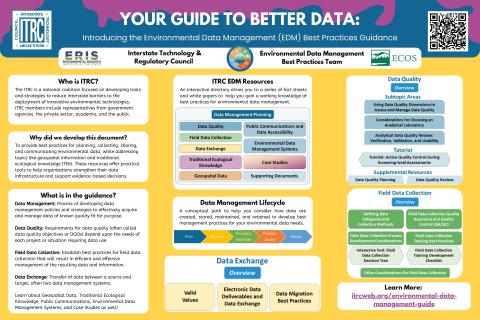 | Environmental data management (EDM) plays a critical role in supporting decision-making across environmental research, regulation, and remediation. Each year, the United States invests billions of dollars to collect, analyze, and interpret environmental monitoring data. The volume of this data continues to grow as scientists investigate more sites, identify emerging contaminants of concern, and adopt automated monitoring tools, including mobile technologies. Despite EDM’s increasing importance, the environmental field faces major challenges due to inconsistent, outdated, or poorly coordinated data management practices. These issues result in fragmented data silos, limited data sharing, and costly decisions based on incomplete or poor-quality information. To address these challenges, ITRC formed the Environmental Data Management Best Practices (EDMBP) Team in 2021. The team set out to develop a series of guidance documents outlining best practices across all phases of EDM. It quickly grew to include over 300 members representing a wide range of expertise. More than 100 participants came from state, city, and local government agencies, working collaboratively with colleagues from federal agencies, academia, industry, public stakeholder groups, and international governments. In 2022, the EDMBP Team published a suite of guidance materials—including fact sheets, white papers, subtopic summaries, interactive tools, and checklists—designed to modernize and blend data management practices throughout the environmental data lifecycle. The content is organized into key subject areas such as Data Management Planning, Data Quality, Field Data Collection, Data Exchange, Public Communication, and specialized topics like Geospatial Data and Traditional Ecological Knowledge (TEK). Each section includes practical tools, case studies, and recommendations to help agencies, consultants, and stakeholders strengthen data governance, improve data quality, and enhance accessibility and interoperability. Coauthors: Brian Pointer (North Carolina Department of Environmental Quality); Doug Morrison (New York State Department of Environmental Conservation); Steve Brauner (Environmental Works, Inc.) |
Improving Your Site Characterization: Introducing the Advanced Site Characterization Tools (ASCT) Guidance Charles Reyes, Interstate Technology & Regulatory Council ► View poster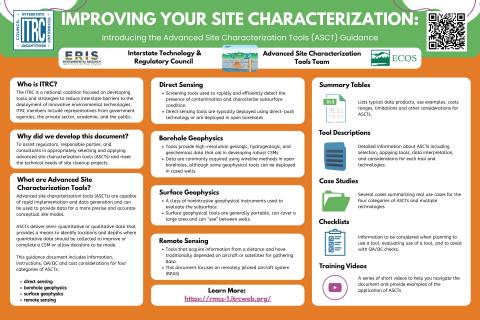
| Numerous advanced site characterization tools (ASCTs) have been developed to generate rich qualitative and semi-quantitative data across a wide range of contaminant types and geological conditions. These tools, ranging from surface and borehole geophysical methods to direct sensing and real-time field analytical techniques, have demonstrated the limitations of traditional sampling approaches, which often rely on discrete data points and can fail to accurately represent complex subsurface conditions. Incomplete or inaccurate site characterization can lead to flawed remedial designs, extended cleanup timelines, and significantly higher costs for stakeholders. To help address these challenges, ITRC formed the ASCT Team in 2017 to develop practical, user-friendly guidance that supports the appropriate selection, application, and interpretation of ASCTs. The ASCT guidance helps improve conceptual site models (CSMs), reduce uncertainty, and improve decision-making. Although many of these tools have been available for years, they remain underutilized, as they are often perceived as costly, unreliable, or applicable only to complex sites. When properly selected and implemented, ASCTs can streamline site investigations, deepen our understanding of subsurface conditions, and enable more effective and targeted remediation strategies. The 2019 ASCT guidance provides a technology-centric overview organized into four tool categories, supplemented by case studies, summary tables, checklists, and an interactive Excel-based selection tool. This resource reflects a growing effort to bring geophysical, hydrogeological, and biogeochemical innovations into routine site characterization practice. This poster will highlight the ITRC ASCT Team’s key resources, provide an overview of tool categories and use cases, and invite collaboration from researchers and practitioners to support broader adoption of ASCTs. It will also provide information on ITRC’s new ASCT Update Team, which is working on updates to the 2019 guidance to include emerging technologies such as drone-based remote sensing and time-lapse surface resistivity. Coauthors: Alex Wardle (U.S. Environmental Protection Agency); Ed Winner (Remediation Products, Inc.); James Rocco and Lesley Hay Wilson (Sage Risk Solutions, LLC) |
Overcoming Remediation Challenges: Introducing the Remediation Management of Complex Sites Guidance Charles Reyes, Interstate Technology & Regulatory Council ► View poster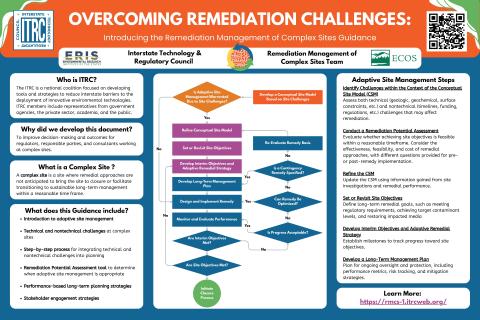 | Complex sites are contaminated locations where achieving remediation goals is particularly difficult due to a combination of technical and nontechnical challenges. These sites often have persistent contamination, complicated geologic or hydrogeologic conditions, and changes in land use that hinder progress toward cleanup. As a result, conventional remediation approaches may be ineffective or unable to achieve closure or even long-term management within a reasonable time frame. To address these challenges, the ITRC Remediation Management of Complex Sites Team was established in 2015. The team developed a comprehensive and flexible framework known as adaptive site management, which emphasizes setting realistic site objectives, establishing interim milestones, and periodically evaluating remedy performance to guide strategic adjustments and maintain progress. Central to this framework is the remediation potential assessment, a screening tool that helps determine whether adaptive site management is warranted and identifies appropriate pathways for long-term decision-making. The guidance was developed with input from more than 400 team members representing state, local, and federal agencies, academia, tribal and public stakeholders, consultants, industry, and international organizations. It supports environmental professionals in identifying and addressing both technical and nontechnical challenges, applying adaptive principles to improve remedial effectiveness, developing performance-based long-term management strategies, engaging stakeholders effectively and transparently, and incorporating real-world case studies and tools to inform decisions. This poster presents the core elements of the adaptive site management framework, including its decision logic, flowchart-based process, and alignment with regulatory expectations under programs such as CERCLA and RCRA. It also highlights new tools for stakeholder engagement and performance tracking, aimed at helping regulators, consultants, responsible parties, and communities navigate the complexities of managing contaminated sites. By applying this guidance, environmental professionals can make better-informed, flexible decisions that support remedy progress while accounting for uncertainty and evolving site conditions. The full ITRC guidance is available at: https://rmcs-1.itrcweb.org. Coauthors: John Price, III (Washington State Department of Ecology), Carl Spreng (Colorado Department of Public Health and Environment), Rula A. Deeb (Geosyntec Consultants) |
A Method Selection Tool to Improve Geophysical and Hydraulic Characterization on the Hanford Site Judy Robinson, Pacific Northwest National Laboratory ► View poster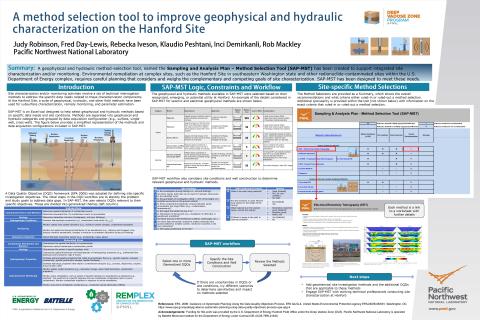 | Environmental remediation at the Hanford Site, a legacy nuclear facility located in southeastern Washington state, requires careful planning that considers and weighs the complementary and competing goals of site characterization. Linking characterization and data quality objectives to appropriate field sampling methods to meet site goals can be challenging, in part, due to project scientist and manager unfamiliarity with the diversity of available field methods and tools from different disciplines. This can lead to an insular and uncoordinated approach to designing a sampling plan, with subject-matter experts (SMEs) in particular methods guiding the discussion, which can limit or prevent the implementation of unfamiliar methods and the cost (e.g. time and cost) savings that could be realized. To provide a common framework when selecting methods to meet Hanford Site goals, we have designed a user-friendly method selection software tool, named the sampling analysis plan (SAP)-method selection tool (MST). The Microsoft Excel-based tool codifies and implements a method selection workflow that assesses user defined data objectives and site characteristics. Based on the inputs, the tool recommends applicable surface and borehole geophysical methods and hydraulic methods, in addition to associated cost and schedule considerations for each method. The SAP-MST provides a broad audience of site professionals with basic knowledge of each method and how complementary methods can be combined to better address project goals. The SAP-MST should not replace subject matter expertise but can augment the SAP process by quickly identifying appropriate methods and reducing preliminary review and discussion time. SAP-MST was designed for the Hanford Site but could easily be generalized or modified to meet another site’s specifications and project characterization needs. Coauthors: Fred Day-Lewis, Rebecka Iveson, Rob Mackley, Klaudio Peshtani, and Inci Demirkanli (PNNL) |
Hydrocarbon Index, Symbol "HI" Albert Sardella, Retired Environmental Consultant for Hydrocarbon Waste ► View poster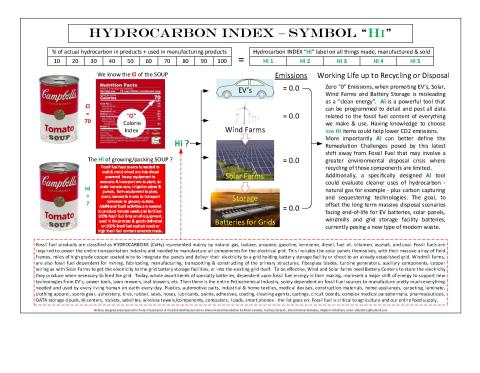 | A Calorie Index, call it "CI", is required label on most all food items prepared for human consumption in the USA. Today no Hydrocarbon Index, or HI label is posted or available on any products manufactured for sale, purchase or for use by populations living in the USA, or for that matter, any country in the world. How does this involve Artificial Intelligence in Revolutionizing Environmental Remediation? One of the main worries in the world today is Global Warming. This has spurred new developments in favor of reducing CO2 emissions. For example, EV's, Wind Energy, Solar Energy, Grid based Battery Storage Facilities for solar and wind energy. Additionally, there are massive new energy requirements to facilitate AI powered facilities, DATA Storage Clouds, Crypto Mining, etc. These are all happening NOW. These new technologies represent a potential of MASSIVE FUTURE VOLUMES of materials that will need recycling capabilities, zero pollution-based remediation or disposal sites. Today we have no measure of these technologies as to their disposal impact. Now is time to begin. So, as an example, what is the HI of an EV one is about to purchase? And how does its HI compare in total to a gas fueled vehicle once each is spent and destine for disposal? Or, the HI of one’s cell phone, a pair of eyeglasses, or prescribed medicine, or a dozen eggs (from hen to store), or in materials to construct a home, a sofa, etc., etc. Hydrocarbon is a primary component to providing the lifestyles we have adopted with the unfortunate bi-product of CO2. A consumer having the ability to view the HI of the item they are about to purchase, to an alternate, can make decisions to select the lower HI product. Like a person wishing to lose weight, selecting lower calorie foods. AI programming has the ability to determine HI data input needed for all things produced for use and consumption. Knowing this allows populations to make wiser decisions to reduce waste, CO2 and lessen remediation. |
OPTIMA: A Web-Based Tool for Performance-Based Optimization of Groundwater Pump-and-Treat Systems Xuehang Song, PNNL ► View poster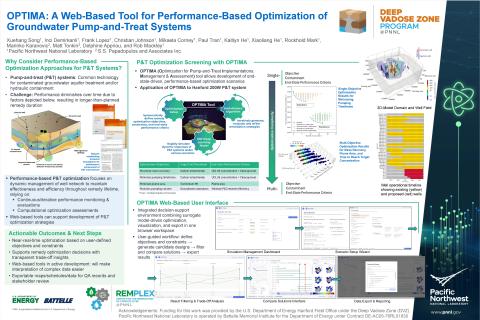 | Sustainable remediation of large-scale groundwater contamination requires tools that can support data-informed, performance-based decision-making. We present OPTIMA (Optimization for Pump-and-Treat Implementations: Management & Assessment), a web-based optimization tool developed to support long-term planning and adaptive management of the 200 West Pump-and-Treat (P&T) system at the Hanford Site. Built within the SOCRATES platform, OPTIMA combines a friendly user interface with advanced modeling and optimization capabilities to help users evaluate complex well placement and pumping strategies. OPTIMA integrates a deep learning surrogate model, based on a U-Net architecture, trained on thousands of physics-based simulations that capture groundwater flow and contaminant transport dynamics. This surrogate model accelerates scenario evaluations by replacing the need for computationally expensive numerical simulations. Coupled with a multi-objective optimization engine (NSGA-II), the tool allows users to explore trade-offs among competing objectives—such as mass removal, hydraulic containment, and drawdown impact—under real-world constraints. The tool supports interactive scenario design, optimization execution, and visualization of performance metrics, enabling transparent exploration of alternative remediation strategies. Recent applications to Hanford’s 200 West Area suggested potential significant improvements in CCl4 cleanup timelines and Tc-99 containment with reduced reliance on trial-and-error modeling. By leveraging artificial intelligence and delivering results through an accessible web-based interface, OPTIMA supports faster, more informed decision-making for complex remediation challenges. A virtual reality (VR) demonstration will accompany the poster to provide attendees with a more immersive understanding of the tool's design and impact. Coauthors: Inci Demirkanli, Frank Lopez, Christian Johnson, Mikaela Corney, Paul Tran, Kaitlyn He, Xiaoliang He, and Mark Rockhold (PNNL); Marinko Karanovic and Matt Tonkin (S.S. Papadopulos and Associates, Inc.); Delphine Appriou and Rob Mackley (PNNL) |
Integrating Physics and AI: An Agentic Tool for Environmental Geophysics Chao Zeng, Pacific Northwest National Laboratory ► View poster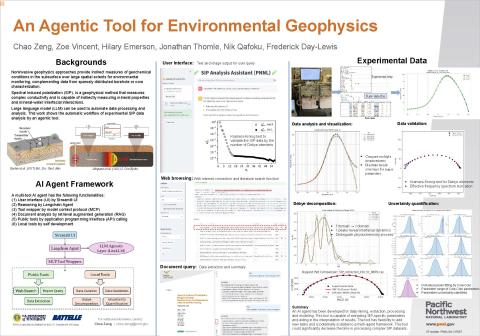 | Emerging generative AI (GenAI) technologies offer new opportunities to enhance environmental remediation by extracting deeper insights from complex geophysical data. We present an interactive, code-free intelligent tool that supports real-time monitoring through three integrated components: data screening, data processing, and uncertainty quantification. Data screening is guided by physics-based models, while Bayesian inference enables robust regression analysis. A conditional diffusion model is used for uncertainty analysis, providing confidence intervals for estimated physical parameters derived from geophysical measurements. This tool is designed for experimentalists and field practitioners to evaluate remediation performance without the need for programming expertise. It streamlines data interpretation, supports rapid decision-making, and enhances transparency in environmental assessments. We demonstrate the tool’s capabilities using spectral induced polarization (SIP) data from a laboratory experiment, highlighting its potential for real-time, AI-assisted remediation monitoring. Coauthors: Zoe Vincent, Hilary Emerson, Jonathan Thomle, Nik Qafoku, and Frederick Day-Lewis (PNNL) |